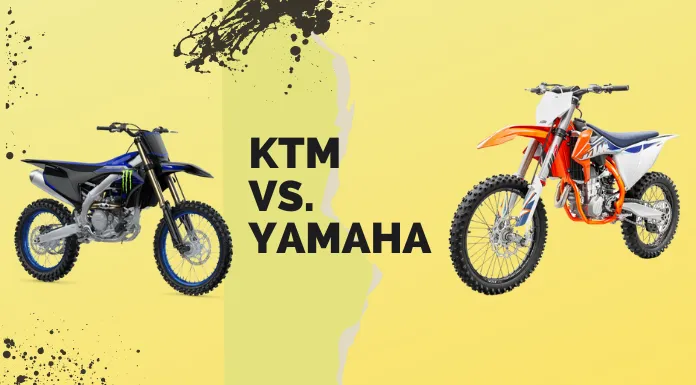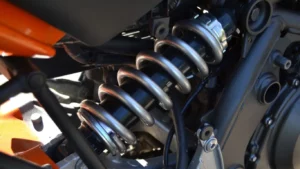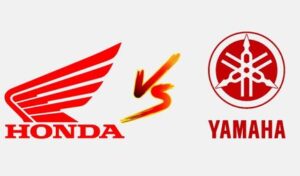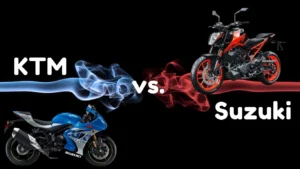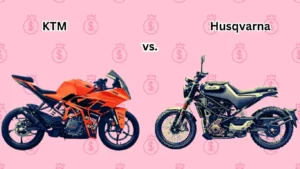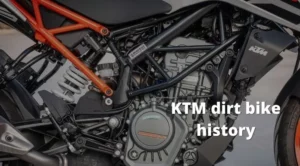The debate between KTM and Yamaha is ever-present in the biking community. We’re here to dissect this discussion, examining parameters like dimensions, ride smoothness, suspension, and more. Getting to the heart of which of these titans aligns best with your biking needs will allow us to crown one as the superior ride.
“Whether you’re an adrenaline junkie thirsting for a fast-paced dirt track adventure, or a nature enthusiast who relishes trail rides, understanding the distinctive qualities of both KTM and Yamaha will help you make an educated decision. So, sit tight and let’s embark on this exciting journey together.”
Before we dive into this in-depth comparison, here’s a quick summary:
- KTM 450XC-F: Renowned for its exceptional handling, top-notch suspension, and explosive power.
- Yamaha YZ450FX: Famous for its robust build, reliability, and impressive control in various terrains.
However, the beauty of these brands isn’t just skin (or, in this case, metal) deep, it’s about how their unique features cater to different segments of riders. So, let’s throttle up and explore what each has to offer!
Breaking Down the Brands: KTM and Yamaha
When it comes to engine performance, KTM is noted for its dynamic power, while Yamaha shines for its reliable, long-lasting performance. If we touch the Price factor, Yamaha usually comes out as the less expensive option, while KTM includes high-end gear as standard.
Also, when thinking about Resale Value, Yamaha bikes tend to retain their value better because of their known durability. On the other hand, high-performance KTM models can show more signs of wear, which can impact their resale value.
On the topic of Durability and Maintenance, Yamaha motorcycles are praised for their toughness and easy upkeep. KTM models, as high-performance vehicles, may need more careful maintenance.
In terms of Adventure and Long-distance riding, KTM is known for a wide variety of models celebrated for their comfort and adaptability to long journeys. In the Sport and Racing field, KTM, with its strong presence in motorsports, is a go-to choice for racing fans.
1. Bike Power:
When it comes to raw power, both Yamaha and KTM offer competent models that can satisfy most riders’ expectations. You need to pay close attention to how the bike’s power reacts and if it’s suitable for your needs.
KTM is acknowledged for its ability to deliver instant power upon demand. This could be perfect for those seeking thrill and excitement from their rides. KTM’s models, especially the performance ones, are often described as beasts that unleash enormous firepower. They are ready to attack any off-road trail with their powerful engines.
In contrast, Yamaha is known for providing power more smoothly. Yamaha’s power delivery won’t surprise you, but it will always be reliable, and there when you need it. Yamaha engines might not provide the instant punch like KTM but they are usually smoother, which is advantageous for beginners or anyone who prefers a more relaxed ride.
2. Engine Longevity:
When choosing a bike, the engine’s lifespan is crucial. It’s not just about how much power the engine delivers, but also how long it can sustain that performance.
Yamaha engines are known for their durability and reliability. With routine care, a Yamaha bike should serve you well for many years.
Contrarily, KTM engines, while delivering excellent power, tend to require more upkeep. Their high power output puts more stress on the engine, which may result in more frequent maintenance needs as compared to a Yamaha.
3. Off-Road Suitability:
To be honest, both Yamaha and KTM make motorcycles that are perfectly suited to off-road conditions. The key difference comes in the fine details.
Generally, KTM off-road bikes are known for their responsive handling and agility. Their lightweight structure makes them excellent for off-road adventures where quick manoeuvring is essential, like cross-country racing or trail riding. When you’re carving your way through a forest or climbing a rocky hillside, you would appreciate the nimbleness of a KTM.
4. Motorcycle Insurance Costs: KTM vs Yamaha
If you’re thinking about long-term costs, you might be curious about the difference in insurance between KTM and Yamaha. Generally, Yamaha might be cheaper because they offer a lot of beginner and mid-range bikes, while KTM is known for their high-performance models.
But remember that things like your driving record, engine size, your experience, and where you live can also change the cost. For the most accurate price, ask insurance companies directly with the specific model and year of the bike you’re interested in from each brand.
5. Street Riding:
For street riding, on the other hand, you might find different strengths surface. Yamaha’s street motorcycles are often praised for their comfortable ride and commuter-friendly features. They offer a blend of performance and convenience that makes street riding a treat.
On the streets, KTM motorcycles might lean more towards the sportier side of things. They are known to deliver a livelier ride with stronger acceleration and generally offer a sportier outlook, which may appeal more to thrill-seekers and riders with a knack for sport riding.
6. Aesthetics:
Aesthetics are, of course, subjective and based on personal preference, but let’s touch upon it briefly. KTM bikes are distinguished by their bold, vibrant “ready to race” appearance which aligns with their sporty pedigree.
Yamaha motorcycles are typically sleeker, with a more refined and classic appearance. Both brands offer a great appeal in their own ways, depending on what you’re looking for in your motorcycle’s visual style.
7. Dependability Score:
When it comes to reliability, many feel that Yamaha takes the lead. It’s a common belief that Japanese bikes like Yamaha are very durable and reliable. This belief is backed up by many long-term reviews and reliability studies, where Yamaha often scores higher than KTM.
However, don’t make a snap decision. KTM has been getting better at reliability year after year, and there are dedicated KTM riders who wouldn’t trade their bikes for anything. Remember: how well a bike performs usually reflects how well its owner takes care of it, and this is true no matter what brand it is.
8. Lifespan:
Yamaha might have a slight edge when it comes to engine lifespan. Their engines are notoriously durable, providing many years of service to riders. That being said, KTM’s lifespan isn’t much different. With routine maintenance, KTM bikes can rack up substantial mileage. Plus, KTM’s innovative designs often result in lighter, more responsive bikes, which some riders might find more appealing than a slightly longer lifespan.
Your decision may heavily rely on personal preference: if long-lasting reliability is key to you, Yamaha could be the better choice. But, if you crave high-performing, leading-edge dynamics, a KTM motorcycle might just be your perfect ride.
9. Spare Parts and Servicing:
When talking about reliability, we can’t forget about the accessibility and cost of spare parts, as well as the ease of servicing. Yamaha, with their widespread global network, typically provides an easier time in obtaining parts and servicing. This means fewer headaches when you need a repair.
On the other hand, finding KTM parts can sometimes be difficult and pricey. Moreover, KTM bikes often need specialist skills for servicing due to their distinct and intricate designs. Then again, for some riders, this uniqueness and the challenge it brings are part of what makes owning a KTM thrilling.
In the end, what matters most is your personal riding experience preferences. Both KTM and Yamaha have their strengths and drawbacks, and understanding them helps you find the brand that suits you best.
10. Braking Systems: KTM Vs Yamaha
For those thrill-seekers who crave the ultimate control, understanding the braking systems of your potential bike is vital. On one hand, KTM is renowned for its Brembo brakes, offering a strong grab and superior stopping power. These brakes perform exceptionally well, particularly during off-road rides or demanding tracks. They provide accurate and predictable responses, instilling confidence in the rider.
Yamaha, on the other hand, employs Nissin brake systems. Although deemed slightly less aggressive than Brembo, they are appreciated for their smooth, progressive, and reliable functioning. Yamaha bikes often present a gentler introduction to powerful braking, perfect for beginners or the more cautious rider.
11. KTM vs Yamaha price
If you’re thinking about the cost of buying a motorcycle, Yamaha bikes are usually less expensive than KTMs. KTM bikes often have a higher price tag because they focus on quality, superior performance, and cutting-edge technology. But Yamaha bikes offer a great mix of performance and value for money.
But don’t just think about the upfront cost. You also need to think about upkeep, upgrades, and repairs. While you might pay more for a KTM bike at first, they’re made with high-quality parts. This could save you money in the long run.
12. Build Quality: Durability Comparison
In terms of build quality, both KTM and Yamaha have proven themselves dependable, with dedication to top-notch manufacturing processes. KTM, originating from Austria, is praised for meticulous engineering. The bikes are designed for durability and high performance, demonstrated through their off-road superiority as well as street riding.
Yamaha, a Japanese brand, holds an equally enviable reputation for its quality construction. Their bikes are known to stand the test of time, offering consistent performance over the years. Plus, the polished finish and attention to detail on Yamaha bikes add to the overall visual appeal, making them a hit among motorcycle enthusiasts.
13. Color Offerings: Express your personality
Both Yamaha and KTM understand that your bike is an extension of your personality. So, color offerings can be a vital factor in your purchase decision.
Yamaha usually sticks to their classic blue, white and black scheme across most models. The iconic Yamaha Blue is much loved and gives a sense of unity in their models. However, if you’re looking for more plentiful color choices, KTM may get your attention. They provide a variant of bright, bold colors like orange, white, and black, that make their bikes stand out and match your boldness.
While the color should not be the only determinant, never underestimate the pride in owning a bike that resonates with your style.
14. Body Work and Aerodynamics: Affecting speed and control
Motorcycles’ bodywork and aerodynamics can significantly affect speed and control, especially during those high-speed rides.
Yamaha maintains a traditional comfort-inclined set-up, with a perfect mix of aesthetics and convenience. The bodywork is thoughtfully designed to reduce wind drag, thus allowing greater speeds.
On the other hand, KTM takes a more aggressive approach. Its sharp angles not only look splendid but also boost the aerodynamics of the bike, helping you control the vehicle even under intense speeds. It suggests that KTM places both an exciting look and ride stability high on their list of priorities.
So, if you plan to hit some high-speed terrains often, you’d want to know how your desired model fares in the aerodynamics game.
15. Seats and Positioning: Priority to comfort and ease
The seats and rider-to-handlebar positioning can significantly impact your comfort during long or strenuous rides.
In this respect, Yamaha scores with its comfortable seat and upright positioning that eases the strain on your body during lengthy rides or commutes. Furthermore, they allow easy adjustments to cater to different rider heights.
KTM, conversely, offers seats designed for aggressive riding. They facilitate an forward-leaning rider positioning that can seem more fitting for sporty rides. While some find this thrilling, it may not provide the utmost comfort during a lengthy journey.
So, depending on the kind of rides you frequently undertake, you should consider the seating and positioning aspects of your prospective bike.
16. Handling and Maneuverability: A Ride Experience
Let’s dive right into one of the distinct attributes that separate the two giants in the world of motorcycles; handling and maneuverability. This can be a game-changer in your decision to pick between these two brands.
Both KTM and Yamaha have a reputation for building bikes that offer excellent handling and superior maneuverability. However, each brand has its nuances. KTM motorcycles tend to perform exceptionally well off-road. They’re equipped with feather-light frames, allowing you to dance around trails with ease, while their top-tier suspension systems soak up bumps and jumps.
Yamaha, on the other hand, has a slight edge when it comes to street riding. Their bikes are known for their embrace of both comfort and control, striking a balance that few manufacturers can quite match. Whether you’re leaning into fast corners or negotiating downtown traffic, the maneuverability of Yamaha motorcycles shines brightly.
17. Technology: Cutting-Edge Innovations
The conversation about KTM vs Yamaha wouldn’t be complete without discussing their technological advancements. Both brands have invested significantly in research and development to enhance the riding experience.
KTM leads the pack in integrating state-of-the-art technology into their bikes. From innovative ABS systems to engine management systems, KTM ensures that their motorcycles are not just about raw power, but also about safe, optimized, and fun riding experiences.
Yamaha isn’t far behind. They’ve been pioneers in bringing some sought-after features to motorcycles, including variable valve timing and electronic fuel injection. Yamaha is committed to delivering a seamless riding experience, also noting the importance of rider comfort and intuitive controls.
18. Resale Value: An Investment Outlook
Lastly, but definitely a factor you should consider, is the resale value. Most motorcycles depreciate over time, but how rapidly they depreciate can affect your return on investment. History shows that Yamaha motorcycles enjoy a slight advantage in this area, often retaining their value better over time.
KTM bikes, while recognized for their outstanding performance and durability, sometimes don’t hold their value as well in the secondhand market. This state of affairs is largely due to their niche status and specialized focus on off-road racing machines.
19. Engine Performance of KTM Vs Yamaha: Strengths and Capabilities
In terms of engine power, KTM bikes often shine. Their large engines, notable for high horsepower, are a staple characteristic, often providing a thrilling power experience. KTM motorcycles usually feature four-stroke, single-cylinder engines that offer a strong and thrilling ride.
These engines are built to hold up under intense pressures, adding to the bike’s longevity. Riders appreciate the immediate throttle response and exceptional torque at low RPMs, making KTM motorcycles perfect for both city and off-road adventures.
Yamaha motorcycles are appreciated for their consistent engine performance. Their engines, often featuring a parallel twin or single-cylinder configuration, emphasizes efficiency and longevity. The smooth power delivery across various RPMs offers riders a controlled and balanced ride on both urban streets and rough terrains.
21. Performance Comparison: The Battle of Horsepowers
When comparing horsepower, KTM typically has more. But, Yamaha has consistent power throughout the speed range, which is beneficial for long trips or steady cruising. So, choosing a KTM or Yamaha depends on what you like and how you ride. If you love speed and power, you might prefer a KTM. If you want smooth rides with comfort and good speed, a Yamaha may be better for you.
Power and Speed: A Comparative Look at KTM and Yamaha
KTM and Yamaha are both famous for their strong and fast bikes. Knowing the small differences between them can help you choose the right one for you.
Take the KTM 690 Duke for instance, it has a powerful single-cylinder engine giving out 72 horsepower and 73.5 Nm of torque. It’s excellent at acceleration, showing exactly what KTM has to offer in terms of performance.
On the other hand, the Yamaha YZF R1, with its extraordinary crossplane engine and a mighty 200 horsepower, goes faster than the Duke. This powerful bike also has modern electronics and great aerodynamics for better control at high speeds.
Best Motorcycle Brand KTM Yamaha
Pitting two top models against each other, let’s carefully examine KTM’s 1290 Super Duke R and Yamaha’s YZF R1.
KTM 1290 Super Duke R
The KTM 1290 Super Duke R, known as the ‘Beast’, boasts a potent 1301 cc engine that outputs a formidable 177 bhp, complemented by top-tier handling. Despite its slightly heavy dry weight of 416 lbs, it offers remarkable agility. It also comes equipped with LED lights, a TFT display screen, and superior Brembo brakes.
Yamaha YZF R1
The Yamaha YZF R1 is all about accuracy, driven by a 998 cc engine that puts out 197 bhp. Its edge includes the latest tech: the Quick Shift System, various ride modes, and Engine Brake Management. Weighing in at 448 lbs, it maintains a steady pace with its sleek design.
Choosing between the KTM 1290 Super Duke R and the Yamaha YZF R1 comes down to your ride style and preference. If you’re after speed and power, KTM is your pick. But, if precision, control, and high tech are what you’re after, Yamaha fits the bill. No matter what, you can trust both brands to deliver quality and performance.
| Features | KTM | Yamaha |
|---|---|---|
| Power | Considerable | High |
| Engine Longevity | Average | Excellent |
| Off-Road Suitability | Outstanding | Good |
| Street Riding | Good | Excellent |
| Aesthetics | Sleek and Modern | Classic and Polished |
| Dependability Score | Good | Great |
| Lifespan | Dependent on usage pattern | Long-lasting |
| Spare Parts and Servicing | Easily available | Widespread availability |
| Braking Systems | Superior | Reliable |
| Comfort Levels | Satisfactory | High |
| Build Quality | Durable | High quality materials used |
| Color Offerings | Vibrant and fresh | Classic and sophisticated |
| Body Work and Aerodynamics | Innovative | Streamlined |
| Seats and Positioning | Geared towards sports enthusiasts | Suits a variety of styles |
| Handling and Maneuverability | Impressive in off-road conditions | Solid all-terrain performance |
| Technology | Cutting-edge | Constantly evolving |
| Resale Value | Good | Higher than most brands |
| Engine Performance | Powerful | Consistent |
Conclusion
In the end, both KTM and Yamaha are great at what they do, and the choice comes down to your personal riding style, whether you prefer off-road thrills or a powerful engine with good resale value. Both brands are well-respected in the motorbike world. Before you choose, it’s important to take a test drive, look at the bike details, ask for advice and check out the local market. The best bike for you will be one that feels comfortable and gives you the confidence and excitement to ride.
